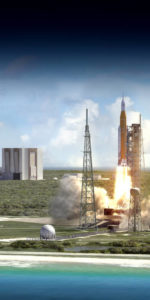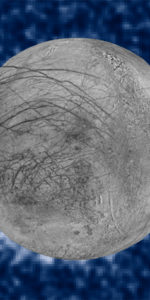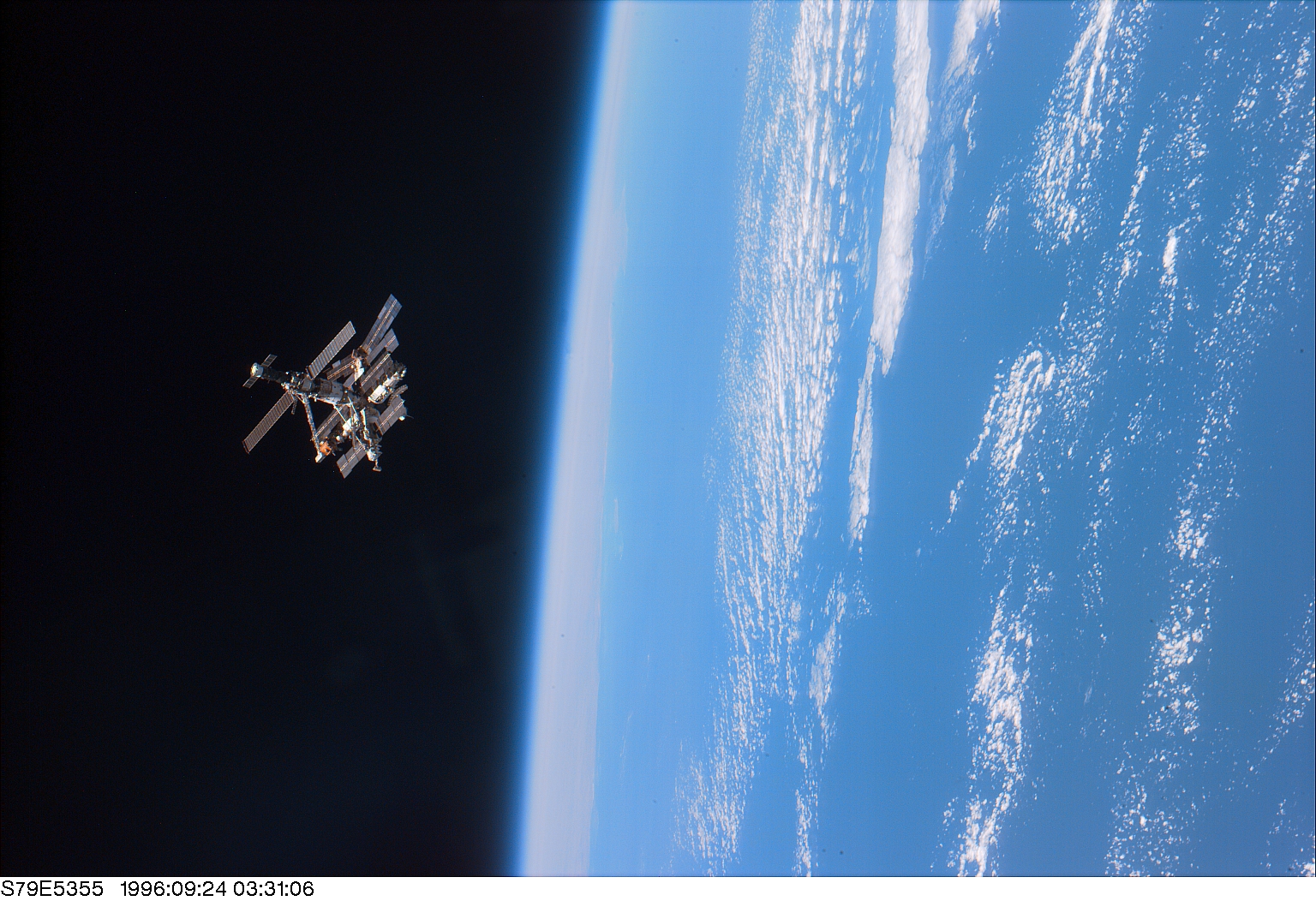
A glass half-full, or half-empty, was Bill Readdy’s perspective on the accomplishment of his fellow astronaut Shannon Lucid, who unexpectedly secured the record for the longest single mission ever undertaken by a woman and the most experienced U.S. spacefarer, 20 years ago, this month. In September 1996, Readdy commanded Shuttle Atlantis on STS-79, the fourth rendezvous and docking mission to Russia’s Mir space station. As outlined in yesterday’s AmericaSpace history article, Readdy and his crewmates—Pilot Terry Wilcutt and Mission Specialists Jay Apt, Tom Akers, and Carl Walz—brought Lucid back to Earth after six months in orbit and dropped off another astronaut, John Blaha, to press ahead with the next stage of a continuous U.S. presence aboard Mir, which would not end until mid-1998.
After many delays, Atlantis roared into the night at 4:54 a.m. EDT on 16 September 1996, generating a glorious spectacle not only for observers on the eastern seaboard of the United States, but also for Lucid herself, from her lofty perch aboard Mir. She was accompanied by a pair of Russian cosmonauts, Valeri Korzun and Aleksandr Kaleri, and her return home had already been delayed since early August. Nonetheless, she had already smashed Norm Thagard’s 115-day single-mission national record for the United States and his 140-day career total record for an American astronaut. By the time Lucid’s feet again touched terra firma, she would have accrued 188 days on her Mir mission and 223 days across the five spaceflights of her NASA career.
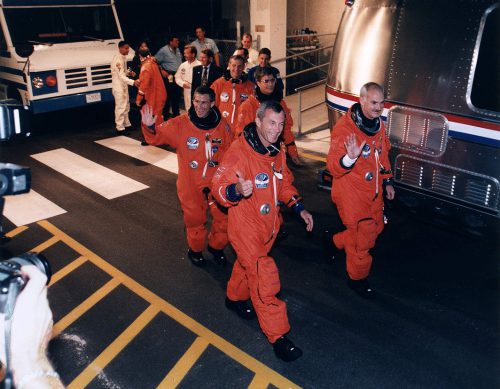
Atlantis’ ascent to orbit was nominal, with the exception of a premature shutdown of one of her Auxiliary Power Units (APUs), which led the Mission Management Team (MMT) to briefly consider bringing the Mir docking a day earlier than planned. At length, it was decided to revert to the original timeline, docking on 18 September, and Readdy and Wilcutt oversaw a series of critical maneuvers to achieve that end. Having launched in the dead of night, the crew was typically awakened in the late evening and after their first sleep period they were roused to the sounds of Gene Chandler’s “Duke of Earl.” This had been especially chosen by Walz’s wife, in honor of their 20th wedding anniversary.
Walz had gained a measure of fame as an Elvis Presley impersonator, which had led him into the astronaut corps’ rock band, as the lead singer. It is interesting that his STS-79 crewmate Wilcutt had much to do with this. On a survival training expedition in Spokane, Wash., in the early 1990s, Walz and Wilcutt were talking in a bar. Walz happened to mention his previous singing experience with a Cleveland band called “The Fabulous Blue Moons.” Wilcutt challenged him to sing a few Elvis numbers with the bar’s resident band, which he did. The rest was history.
Commanding Atlantis for STS-79, Readdy had followed an interesting route to Mir, which might—at one stage—have seen him fly a long-duration mission himself, or even journey downhill aboard a Soyuz. After flying his second shuttle mission in the early fall of 1993, Readdy was appointed NASA’s second director of operations at the Star City cosmonauts training center, on the forested outskirts of Moscow, in July 1994. Four months later, he was replaced by fellow astronaut Ron Sega and assigned to command STS-79. In his oral history, Readdy expressed surprise at being notified of his assignment by fax. “When the faxes were working over there [in Star City], when the phones were working over there, we were just ecstatic,” he said later. “And when the fax rolled out of the machine on that curly paper, it was kind of a pleasant way to leave Star City with a mission assignment.”
Yet Readdy’s “mission” might have been quite different. One early plan was to fly him to Mir on STS-71—the first shuttle docking mission to the station—and leave him there for about a month. Readdy would then return to Earth with cosmonauts Anatoli Solovyov and Nikolai Budarin, aboard a Soyuz spacecraft, offering the United States valuable experience of flying the Russian vehicle. “The plan was to train as Norm Thagard’s backup on the Mir-18 flight,” Readdy told the NASA oral historian. “At that time, there was a Mir-18A and a Mir-18B and the Mir-18B part was to fly up on 71 and then come back on the Soyuz.” The plan made practical sense, for since late 1992 NASA had been investigating the use of Soyuz as a potential Assured Crew Return Vehicle (ACRV) for Space Station Freedom. Since Thagard would see the “ascent” phase of the Soyuz TM-21 mission, Readdy would see its “descent” phase. Readdy himself made little further reference to Mir-18B, although the unrealized mission was explored in Bryan Burrough’s book, Dragonfly, although primarily as a means of uncovering the alleged political machinations of NASA’s senior leadership.
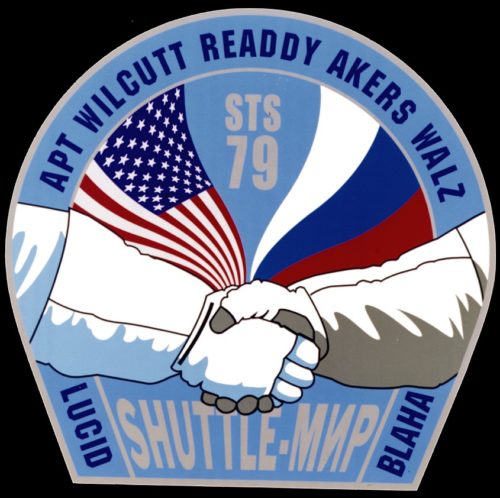
Several months later, in April 1995, Readdy’s STS-79 crewmates were identified. At one stage, the mission was intended to feature an EVA by Apt and Walz and, indeed, when the crew produced their official patch, it included a pair of space suit gloves shaking hands. However, the EVA was ultimately moved to STS-76 instead. “We didn’t have an EVA,” said Readdy in his NASA oral history interview. “As it turned out, that was one of the unpleasant surprises.”
As the pilots focused on the Mir rendezvous, Apt and Walz were responsible for activating the bulk of the payloads in the first Spacehab double module. Readdy and Wilcutt accomplished a smooth R-Bar rendezvous and docking with Mir at 11:13 p.m. EDT on 18 September, a little more than two days into the mission, as the combined spacecraft flew high over the Carpathian Mountains, to the west of Kiev. Hatches were opened two hours later. A brief welcoming ceremony was followed by Blaha and Lucid assuming their respective roles as members of different crews: The former transferred his molded seat liner over to the Soyuz TM-23 spacecraft, which he would use in the event of a contingency return to Earth, whilst the latter moved her equipment over to Atlantis and formally joined STS-79.
For all six astronauts, it was the first time that they had seen Lucid in over six months and Wilcutt, for one, was amazed at the extent to which she had adapted and become a creature of weightlessness. “All the long-duration crew members who spent time on Mir said that after about a month, they noticed a difference in themselves,” he told a Smithsonian interviewer, several years later. “They’d truly adapted to zero-G. I could see it with Shannon Lucid. She was so graceful; there was never an unnecessary motion. She could hover in front of a display when anyone else would be constantly touching something to hold their position.”
Almost immediately, the process of transferring the largest complement of equipment and supplies between the shuttle and Mir got underway. It was a process overseen by Akers, who employed a specialised inventory monitoring system and bar code recorder to effectively keep track of all of the items. “A lot bigger than my office,” was Akers’ summary of the spaciousness of the double Spacehab. In his mind, the ability to handle packages in the soft stowage bags, rather than individual small items, made it easier to transfer materials to and from Mir. Akers compared the process to FedEx or UPS and felt that packaging items in groups made it far easier to inventory them.
The sole difficulty was understanding the “down-stowage” plan—what was coming back to Earth from Mir—in good time. “That was contingent on knowing how Shannon had packed all of her return items,” Akers reflected. “We didn’t get that information until a couple of days before launch, because of communications problems. Shannon had done a great job of packing, had everything ready, but the communication of finding out exactly where everything was, so we knew how heavy each package was, which determines how the loads are done, that’s one thing we want to do differently.”
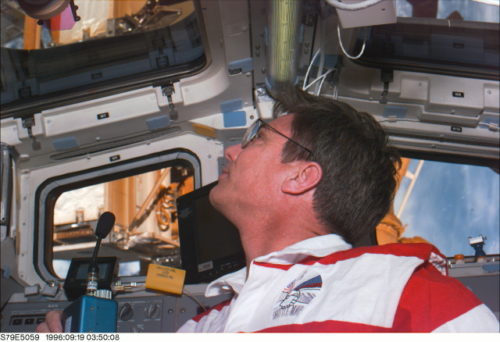
Watching and participating in these full-on, 18-hour days, Blaha had nothing but praise for the shuttle crew as they accomplished all of this work. “Each evening,” he said, “the STS-79 crew and the Mir crew met for dinner either on Mir or Atlantis. These were unforgettable times. I will always remember how they all helped me move into my new home.” A farewell meal in Mir’s base block, early on 23 September, was followed by the movement of the respective crews back to their respective spacecraft for undocking. At 8:00 a.m. EDT, Korzun and Blaha closed the Kristall module’s hatch and the vestibule between the station and the shuttle was depressurized.
After an abbreviated, six-hour sleep period, Readdy undocked from Mir at 9:33 p.m. EDT and after departing to a safe separation distance Wilcutt took control of the orbiter for the customary fly-around inspection. With only two fully functional APUs, the weather criteria for a landing on 26 September were more restrictive than normal. Weather conditions at the Shuttle Landing Facility (SLF) at the Kennedy Space Center (KSC) in Florida appeared to be acceptable, with only scattered clouds and light winds in the vicinity of the runway, whilst Edwards Air Force Base, Calif., offered a backup capability if necessary.
For Lucid, returning home after six months in space, much of her time was spent exercising to condition herself for the punishing return to terrestrial gravity. At 7:06 a.m. EDT on 26 September, 188 days since Lucid left Earth, Bill Readdy fired Atlantis’ engines to begin the irreversible deorbit burn and bring her back home. A little over an hour later, at 8:13, he crossed the eastern seaboard over the state of Georgia and guided his ship into Florida airspace and to a smooth touchdown on Runway 15.
“Depending on whether you want to look at the glass as half-full or half-empty, it meant that Shannon had to spend an awful lot longer on Mir than she had planned,” said Readdy in praise of his crewmate’s accomplishment. “I think Shannon’s girlhood dream to run her own laboratory was such that … it fit right in with her plan and it also allowed her to set the world record for time in space” for women. In fact, Lucid’s record for the longest single space mission ever undertaken by an American citizen would remain unbroken until June 2002 and her record for the longest single mission ever undertaken by a woman would endure still longer, until June 2007.
This is part of a series of history articles, which will appear each weekend, barring any major news stories. Next week’s article will focus on the 50th anniversary of the Apollo 2 crew assignment, an assignment which brought disappointment and eventual tragedy, but whose members formed a key part of America’s goal of reaching the Moon.
Want to keep up-to-date with all things space? Be sure to “Like” AmericaSpace on Facebook and follow us on Twitter: @AmericaSpace




